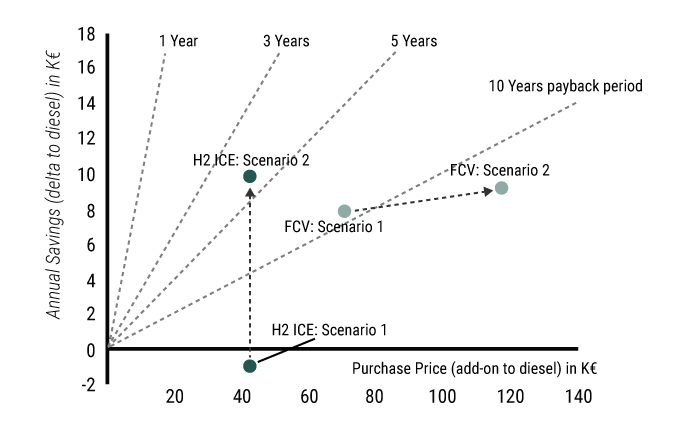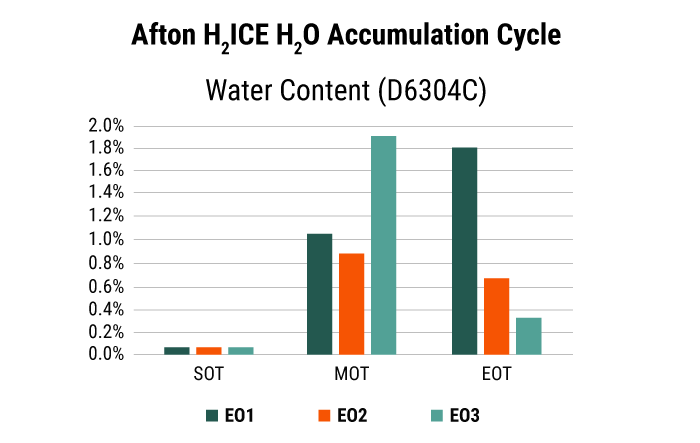
There is no single route to a zero-carbon future for commercial vehicles. Having squeezed every drop of efficiency from conventional combustion engines, the latest emissions legislation demands increased electrification—yet battery technology still lacks the maturity to support many heavy-duty applications.
Hydrogen Internal Combustion Engines (H2ICE) could play a leading role in helping original equipment manufacturers to navigate the middle ground, but they bring new challenges and risks, particularly around pre-ignition and water handling, both of which are influenced by engine oil performance.
Combining their heavy-duty diesel expertise with their in-depth knowledge of gasoline pre-ignition, Afton Chemical has been building a deep understanding of these challenges to develop predictive tests for lubricants and enable the formulation of targeted solutions. Broad industry engagement will be needed to establish meaningful industry-standard tests that address real world concerns and enable OEMs to exploit the full potential of hydrogen.
Legislative Forces
Europe has previously established the lowest CO2 emissions standards and the European Commission has proposed to go even further for heavy-duty vehicles. Its vision now mandates a 45% CO2 reduction by 2030, a 65% reduction by 2035 and a 90% reduction by 2040. Exact numbers will vary across OEMs due to differences in fleet composition.
“The previous EU standards included a 15% CO2 reduction by 2025, which is feasible with conventional combustion engines. Meeting this target means that OEMs must optimize the efficiency of every aspect of a commercial vehicle, but the 15% reduction is achievable with current technology,” said Alan Henderson, marketing manager for heavy-duty engine oil at Afton Chemical. “The proposed 30% CO2 reduction by 2030 would have needed a degree of hybrid electric technology. But the latest revision—the 45% reduction—raises the bar considerably and would require OEMs to electrify around a third of their fleet to avoid significant financial penalties.”
Battery Evolution
For many commercial vehicle applications, battery technology is not yet sufficiently advanced for full electrification. Today’s large, heavy batteries are not ideal for long haul trucks, as too much payload space and weight is sacrificed to carry them. Charging infrastructure is still nascent and barely sufficient to service a burgeoning passenger car fleet. Taking frequent, long breaks to recharge truck batteries, on top of lost payload space, is not conducive to profitable fleet operations.
Hydrogen fuel cells offer an alternative route for electrifying commercial vehicles. Although not as energy efficient as batteries in well-to-wheel terms, fuel cells take up less space and weight and can be refueled much more quickly than batteries can currently be recharged. From a durability standpoint, fuel cells have yet to prove themselves and are sensitive to contaminants, requiring a supply of pure hydrogen.
“Based on past experience, battery technology should, over time, advance sufficiently to meet the demands of commercial trucks,” Henderson suggested. “Long-life, low-cost, lightweight batteries and a widespread fast-charging infrastructure are unlikely to be widely available much before 2040, when they will be vital for achieving the 90% CO2 reduction target.”
Figure 1. European Carbon Dioxide Reductions

Source: ICCT, ANALYZING EUROPE’S CO2 STANDARDS PROPOSAL FOR TRUCKS AND BUSES, 2023. Licensed under CC BY-SA 4.0
If OEMs must wait up to two decades for batteries to catch up, what are their options for compliance with emissions legislation in the meantime? All eyes are turned toward alternative fuels and fuel blends, although it’s unclear which of these will come to the fore; indeed, the choice of fuel may vary by application. OEMs may elect to build multi-fuel capability into future engine designs to allow for any eventuality.
Navigating the Messy Middle
This period of transition to electrification has been termed the “messy middle” by the North American Council for Freight Efficiency. It is a time when existing technologies and alternative fuels must be leveraged while full electric solutions develop to maturity.
For long haul trucks in particular, hydrogen as a combustion fuel could offer a welcome pathway through this messy middle. Tailpipe CO2 emissions would be minimal, coming only from small amounts of lubricant or potential contaminants in the hydrogen supply, helping work toward that 90% reduction figure.
“Hydrogen will need to be perceived positively from a societal, governmental and regulatory standpoint, and be supported by new infrastructure. None of this is influenceable by the lubricant industry,” Henderson said. “Engine oils can, however, help by promoting efficiency and reducing the total cost of ownership for fleets. They can also help OEMs to unlock the full potential of hydrogen powertrain technology.”
A hydrogen-fueled future is viable in the mid-term, whether powering internal combustion engines (H2ICE) or fuel cells. Both technologies may coexist, being best suited for different applications; OEMs are exploring all the options.
Figure 2. TCO Analysis of Alternative Powertrains, 2030
40 TON, LONG-HAUL: SCENARIO 1 vs SCENARIO 2

Source: FEV Consulting (hydrogen technology cost comparison)
For propelling a vehicle, hydrogen is not as efficient as battery power, which offers 76% well-to-wheel energy efficiency. For fuel cell electric vehicles (FCEVs), that figure drops to 30% and H2ICE is just 22% efficient. However, a benefit of using H2ICE as a transitional technology is that any hydrogen storage and distribution infrastructure established for H2ICE could potentially be used to support FCEVs from 2040 onwards, instead of such investments being rendered obsolete.
Hydrogen Characteristics
H2ICE has several advantages. The combustion engine is a robust and durable platform that is well understood and affordable, which contributes to a lower total cost of ownership. When fueled by hydrogen, ICEs can operate lean, supporting complete combustion, lower engine out emissions and maximum efficiency.
New challenges stem from the properties of hydrogen gas because these impact combustion. Hydrogen’s molecular weight is considerably lower than that of diesel, gasoline or even natural gas. Being lighter than all these fuels makes it harder to deliver high air-to-fuel ratios and necessitates supercharging and/or turbocharging for H2ICE to generate comparable power to a similar displacement diesel engine. A higher flame temperature means higher levels of NOx can be generated from hydrogen combustion, while its low minimum ignition energy and low explosive limit increases the risk of pre-ignition.
Figure 3. Accumulation Cycle

Source: Afton Chemical proprietary test
“Understanding the eccentricities of hydrogen combustion and identifying how this can drive significant differences in lubricant performance requirements is essential for supporting H2ICE development,” said Nathaniel Cain, senior R&D manager at Afton Chemical. “Our initial assessment of five core aspects of lubricant performance highlighted several risk areas.”
Understanding Pre-ignition
The greatest of these risks comes from pre-ignition. With more than a decade of expertise in test methodologies and oil formulation that optimize low-speed pre-ignition performance in gasoline direct injection engines, Afton has leveraged a proprietary pre-ignition test for H2ICE.
“Our preliminary work identified two underlying modes of pre-ignition. One is hot spot induced, caused by combustion chamber surfaces at high temperatures, which is something the lubricant cannot influence. The other is stochastic pre-ignition, and this is where engine oil formulation can have a significant impact. This topic has not yet received enough attention in the industry,” Cain said. “Understanding the formulation levers will be vital for OEMs to unlock the full potential of H2ICE technology.”
Figure 4. Improved Corrosion Control

Source: Afton Chemical proprietary test
Pre-ignition appears to occur more frequently in H2ICE than in gasoline engine tests for passenger car motor oils. To illustrate the phenomenon, Afton shared data from its proprietary testing in which pre-ignition events are compared using two different engine oils.
Formulating for Pre-ignition
With both oils, classic stochastic cycles of pre-ignition can be seen. However, when using Oil B, a different mechanism also occurs: runaway pre-ignition. Here, the stochastic pre-ignition events are followed by additional pre-ignition events, which are increasingly severe and close to each other. This creates a feedback loop, which ultimately requires manual intervention to keep the engine from destroying itself.
Repeat tests indicate that this phenomenon is sensitive to engine oil formulation; however, the lubricant drivers for pre-ignition performance in H2ICE differ from those for gasoline engines. “That is not to say that you can’t formulate engine oils that can work in both hydrogen and gasoline engines. Our research indicates that this is indeed possible. It’s just that the formulation approach for H2ICE is not intuitive,” Cain said.
H2ICE propensity for pre-ignition is sensitive to both hardware and combustion strategies, so the challenge for lubricants is likely to evolve further as OEMs pursue and finalize their different approaches to engine design.
“The industry needs to come together and take a holistic approach to understanding the underlying mechanisms of pre-ignition and lubricant formulation levers. Standardized industry tests are required, so that engine oils can meet the requirements of all OEMs,” Henderson said.
Water Challenges
Pre-ignition is not the only challenge for H2ICE. The main product of hydrogen combustion is water, which can accumulate in the crankcase in varying amounts depending on the drive cycle. Afton has found levels rising as high as 2% when operating under high water accumulation duty cycles, requiring extended water-handling performance from the lubricant.
“Water uptake and ejection is important, but once water starts to accumulate, the lubricant must be able to form a stable emulsion for extended periods, and this emulsion must remain pumpable even at very low temperatures,” Cain said. “Cold starting a hydrogen engine where the emulsion has frozen means that lubricant cannot circulate as it should, resulting in catastrophic engine damage.”
This is no new phenomenon; emulsion freezing is a failure mode in hybrid technology, too. Afton has leveraged its unique expertise in water handling from other applications to help develop formulation solutions for H2ICE.
Corrosion is a related issue, its severity dependent upon how much water accumulates in the combustion chamber during engine cooling. Vapor phase water plays a part, too—especially where combustion gases form acidic solutions. Lubricant films must be able to protect metal surfaces from all forms of humidity, and while some additive chemistries act protectively against corrosion, others can contribute to it.
“Conflicting needs must be balanced in the finished formulation but importantly, performance must also be maintained over the oil drain interval” Cain said. “The classic oil degradation mechanism of nitro-oxidation is also seen in heavy-duty H2ICE, although the engine oil doesn’t suffer from the fuel dilution issues that lead to sludge and varnish formation, nor is there significant soot formation to contend with.”
Applying its learnings from gasoline direct injection, its testing expertise and understanding of chemistry, Afton has mapped the wider formulation space to demonstrate that improved corrosion control can be achieved by the engine oil without compromising other key performance areas.
The Road Ahead
One thing is certain: No two OEMs are likely to follow an identical route to alternative fuels or electrification. The diversity of OEM approaches will contribute to a messy middle, and hydrogen will likely have a role to play during this transition.
Making H2ICE commercially viable requires a deep understanding of pre-ignition challenges and an appreciation of the importance of water handling and corrosion. Engine oil formulation must account for the interaction between different OEM hardware and combustion strategies, drive cycles, lubricants and additive chemistries.
Henderson concluded: “We all need to commit to working together for the long haul. To understanding the underlying challenges and devising robust industry tests. To formulating engine oil solutions based on real-world requirements that can mitigate risk for OEMs and help transport us all safely into a low-carbon future.”
Alan Henderson is marketing manager–heavy-duty engine oils for Afton Chemical Co.
Nathaniel Cain is senior R&D manager–technology development for Afton Chemical Co.